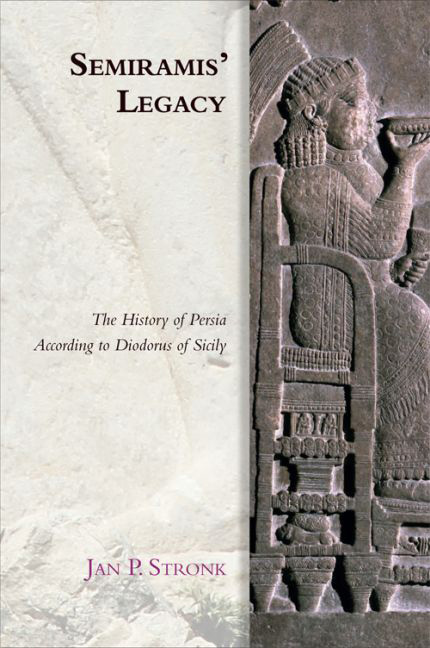Book contents
- Frontmatter
- Contents
- List of Figures and Tables
- Preface
- Abbreviations
- Series Editor's Preface
- Map
- Introduction: Diodorus' Work and Our Sources
- 1 Diodorus’ Sources
- 2 Ancient History: Assyrians, Chaldeans, and Medes
- 3 The Persians and the Greek Wars
- 4 Revolt and Sedition
- 5 Alexander the Great Defeats Darius III
- 6 From Persepolis to Babylon
- 7 The Period of the Diadochs: The Rift Opens
- 8 The Period of the Diadochs: The Rift Deepens
- 9 The Vicissitudes of the Diadoch Kingdoms: The Final Years of Diodorus' Persian Account
- 10 Semiramis' Legacy
- Conclusion
- Bibliography
- Index of Classical Sources
- Index of Modern Authors
- General Index
1 - Diodorus’ Sources
Published online by Cambridge University Press: 10 May 2017
- Frontmatter
- Contents
- List of Figures and Tables
- Preface
- Abbreviations
- Series Editor's Preface
- Map
- Introduction: Diodorus' Work and Our Sources
- 1 Diodorus’ Sources
- 2 Ancient History: Assyrians, Chaldeans, and Medes
- 3 The Persians and the Greek Wars
- 4 Revolt and Sedition
- 5 Alexander the Great Defeats Darius III
- 6 From Persepolis to Babylon
- 7 The Period of the Diadochs: The Rift Opens
- 8 The Period of the Diadochs: The Rift Deepens
- 9 The Vicissitudes of the Diadoch Kingdoms: The Final Years of Diodorus' Persian Account
- 10 Semiramis' Legacy
- Conclusion
- Bibliography
- Index of Classical Sources
- Index of Modern Authors
- General Index
Summary
PRELIMINARY REMARKS
Diodorus generally seems extremely reticent about revealing his sources. Even in the first books, where he enlightens his readers most frequently about the authors he used, their names appear only relatively sporadically. It appears certain at least that Diodorus used Ctesias to compile his second book (Diodorus used specifically Ctesias’ books 1–3, notably featuring Semiramis, and used books 4–6 considerably less), and possibly he also used parts of Ctesias’ books 19–23 (on the reign of Artaxerxes II: see Stronk 2010: 184–8). Whether Diodorus also used other books of the twenty-three constituting Ctesias’ Persica cannot, regrettably, be determined with certainty, though Haillet believes he did (Haillet 2002: xi). Though I was, for reasons of method, unable to include these passages in the text in my edition of Ctesias’ Persian History (Stronk 2010), I concur on this point with Haillet and will discuss such passages in the historical commentary on Ctesias’ Persica I am preparing. Ctesias might well, therefore, be one of the more prominent sources Diodorus used, directly or indirectly (for example through Ephorus), to compile his chapters and paragraphs on the East until c. 390, the year Ctesias concluded his Persica.
To a large extent Diodorus’ sources can only be found through scrutiny of his text (see Haillet 2002: x). Even for our purpose, this seems to be insufficient to determine the sources Diodorus relied on to compose his view on the events in the Assyrian and Median Kingdoms and especially in the Achaemenid Persian Empire (which may be stretched to 304, the year Alexander's last direct relative died: Depuydt 2008: 1, 3) and its successors, the Seleucid, Antigonid, and Arsacid Kingdoms. Pascale Giovannelli-Jouanna and Christine Maisonneuve (in Lenfant 2011: 120–43) argued that Diodorus relied for those parts in his work dedicated to Greece, Asia Minor, and Persia on the works of Herodotus (11.37.6),1 Thucydides, Xenophon (15.76.4 and 15.89.3), Ctesias of Cnidus (for example, 14.46.6), Ephorus of Cyme (14.11.1 (indirect reference) and 16.76.5), Clitarchus of Alexandria, Hieronymus of Cardia (book 17, passim), the Hellenica Oxyrhynchia, and Polybius. To the major sources regarding the region we are interested in, we should perhaps add Isocrates of Athens, Hellanicus of Lesbos (Mytilene), and chronographic sources (Haillet 2002: xi) as well.
- Type
- Chapter
- Information
- Semiramis' LegacyThe History of Persia According to Diodorus of Sicily, pp. 31 - 85Publisher: Edinburgh University PressPrint publication year: 2017



